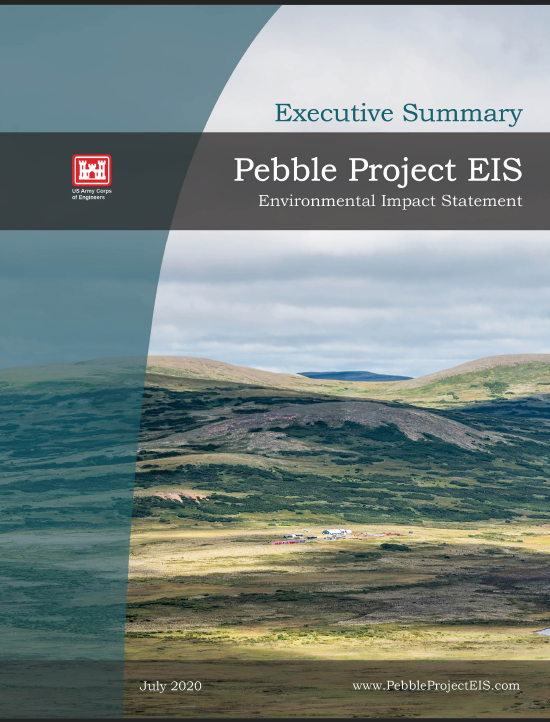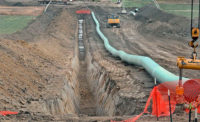A controversial copper, gold and molybdenum mine in an environmentally sensitive region of Alaska got a boost following the release of a final environmental impact statement by the U.S. Army Corps of Engineers on July 24.
The EIS, favorable to the project, was roundly criticized by environmental groups, residents and some lawmakers.
The study concludes that the 8,390-acre Pebble mine site and associated infrastructure, including a pipeline, a 270-MW power plant and an 82-mile road, will have minimal adverse environmental impacts. Development of the mine would destroy about 99 miles of fish habitat and part of 2,200 acres of wetlands that support five species of Pacific salmon, according to the EIS.
The Corps is expected to issue a final record of decision for the project later this summer. Mine developer Northern Dynasty Minerals says it will take two to three years to obtain necessary state permits.
“There is more work to be done, but the publication of the Final EIS today is a clear validation that Pebble can be developed in an environmentally sound and socially responsible way,” Ron Thiessen, president and CEO of Northern Dynasty said in a statement. Tom Collier, mine partnership CEO said, also in a statement, that "from the beginning, we dedicated the time, resources and technical work to ensure we had a project that could be done responsibly ... without harm to the Bristol Bay fishery." He called the Corps review “extensive, rigorous and transparent.”
Regulatory Quagmire
The mine has been in a regulatory quagmire for years. The Obama administration in 2014 prevented developers from even moving forward with the Corps regulatory process, but the Trump administration reversed that stance.
Opponents say the Corps EIS contradicts a 2014 review by the U.S. Environmental Protection Agency that said Pebble Mine would have significant effects on streams, wetlands and fisheries in the Bristol Bay watershed.
“Bristol Bay’s fishermen are counting on EPA to use its veto authority under the Clean Water Act to ensure protection of Bristol Bay,” said Katherine Carscallen, executive director of Commercial Fishermen for Bristol Bay. “We need EPA to stand by its own science, which shows that the Pebble Mine cannot be built without harming our country’s largest source of sustainable wild salmon.”
The mine faces more obstacles, including lawsuits promised by several opponent groups and congressional concerns.
“By pushing the Pebble Mine project forward with a process that leaves many questions unanswered, the Trump administration is ignoring the voices of the tribal communities of Bristol Bay and risking irreplaceable habitats, including one of the world’s last remaining wild salmon runs,” said Rep. Peter DeFazio (D-Ore.), chairman of the House Transportation and Infrastructure Committee, in a statement.
In committee testimony last October, DeFazio said the Pebble proposal would require removal and treatment of 1 billion tons of bulk mining tailings, capture and treatment of about 13,000 gallons per minute of contaminated mine wastewater and construction of five dams, two of which would be 545-ft tall.
“As chair of the committee with oversight of the U.S. Army Corps of Engineers and the Clean Water Act, I will use every tool I have to hold this administration accountable for its failure to protect American communities and our environment,” he said in the current statement.
Issues Not Fully Vetted?
The Natural Resources Defense Council, among other groups and individuals, criticized changes made to the project that were not fully vetted in an earlier draft EIS, including moving port facilities, doubling the amount of dredging needed from that port, and locating a road to the site that would cross land owned by those opposed to the mining project.
The mine will depend on two massive, technically complex water treatment plants for which Pebble has offered only “conceptual” plans that the Corps itself acknowledges are completely untested, according to NRDC. “The design offered by Pebble is, in the words of the Corps, merely a ‘general description’ at the ‘conceptual’ stage,” the group said.
The Corps should have evaluated the consequences of a failure of the tailing facility, which could devastate the watershed, Collin O’Mara, president of the National Wildlife Federation, said. “The administration should instead put a stop to this project and protect Alaska’s salmon and the communities that depend upon Bristol Bay. Since they won’t, we will see them in court.”
Pebble’s design includes a drainage system that allows water or snowmelt to flow into a holding pond, which keeps it from building up inside the tailings facility that could contribute to a spill, the Corps said in the EIS. “Modeling of a catastrophic, very low-probability tailings release was requested by commenters but deemed inappropriate” based on Pebble’s flow-through design of its main tailings storage facility, the Corps said.
“The Army Corps’ absolute lack of regulatory rigor has resulted in a grossly deficient permitting process and woefully inadequate final EIS. The Corps has cut legal corners, relied on incomplete or outmoded science, and failed to require any economic feasibility analysis," said NRDC. "Worse, the Corps has completely ignored the voices of Bristol Bay’s Indigenous peoples and tribes who adamantly oppose the Pebble Mine.”
Two other federal agencies must weigh in on the proposal to complete a NEPA review and a determination on a final permit.
Alaska Native corporations said they will stop the project by refusing to allow access to the site across their lands.






Post a comment to this article
Report Abusive Comment